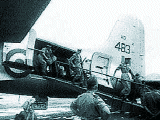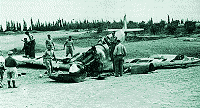The RAF in Palestine
The situation in Palestine, which had been deteriorating since before the end of World War II, came to a head when the King David Hotel, the British Headquarters in Jerusalem, was bombed in July 1946 leaving 91 dead, of whom 28 were British.
The result was that the British units in Palestine were reinforced. A squadron of Halifaxes, No.620 later No.113 Squadron, was moved to Aqir, the main RAF base in Palestine, to become the RAF Airborne Support Unit. The Glider Pilot Regiment was also based at Aqir and was equipped with Horsa gliders. No.621 Squadron spent much of its time flying anti-immigrant patrols, code-named 'Sunburn', flying between Cyprus and Egypt for up to twelve hours at a time. They intercepted and photographed any illegal shipping in the area, some of which fired ineffectively at the Lancasters. A number of the Squadron's aircraft were damaged by sabotage, although none was lost.

Meanwhile, No.32 Squadron, equipped with Spitfires and fresh from fighting in the Greek Civil War, arrived at Ramat David near Haifa on 25th February. Four months later it was joined by a second Spitfire unit, No.208 Squadron. A Tempest wing, comprising Nos. 6, 8 and 249 Squadrons, was sent to the area in 1946. While No.13 Squadron, equipped with photo reconnaissance Mosquitos, was reformed at Ein Shemer on 1st September. No.13 was tasked with searching for and recording ships bringing illegal Jewish immigrants from Europe. No.208 moved to Petah Tiqva, where seven of the aircraft were blown up by Jewish terrorists in February 1946, almost putting the squadron out of action until new equipment arrived in August of that year. The new aircraft were brand-new Spitfire FR18s.

In October 1946 No.32 Squadron moved to Ein Shemer in the south, where it in turn converted to the Spitfire FR18 in June of the following year. Soon after six of the new aircraft were destroyed on the ground by terrorist bombs. The Spitfire squadrons' main task was to search for illegal shipping and anti terrorist patrols but often they were in action in support of 3rd Infantry Brigade, which had been deployed to the south of the country in March 1947. By the end of the year, the British had announced their intention to withdraw from its mandate as soon as possible and the United Nations had decided to partition the country between the Arabs and the Jews, which led to increased hostility between the communities.
Atrocities were committed by both sides and one of the worst examples being the massacre of nearly all the Arab inhabitants of the village of Deir Yassin, near Jerusalem, by Jews in April 1948. Although British forces were not able to prevent the attack, Tempests of No.249 Squadron, armed with rockets, persuaded the Jewish terrorists to leave after a few dummy attacks. A few days earlier four Spitfires of No.208 Squadron had attacked a terrorist hideout situated in a brewery in Bat Yam (meaning 'Daughter of the Sea'), from where their machine gun dominated the area and pinned the Arabs down. The brewery building looked like a block of flats and the Spitfires mistakenly attacked another building, the printing works of E Lewin-Epstein Ltd. Thankfully it was a Saturday and the premises were empty.

On 3rd February 1947, Operation 'Polly' began with Halifaxes of No.113 Squadron evacuating non-essential civilians from Aqir. It was another year before the British troops began their withdrawal. The RAF's role was now to cover the final withdrawal and to take no part in what was now to all intents and purposes a full-scale Arab/Jewish war. The Union Jack was finally lowered in Palestine on 14th May 1948. The next day the independent state of Israel was proclaimed. Within hours, Spitfire IXs of the Royal Egyptian Air Force attacked Tel Aviv and Sde Nov Airfield. One of their aircraft was lost to ground fire, salvaged and subsequently used by the newly created Israeli Air Force.
On the morning of 22nd May, REAF Spitfires attacked Ramat David Airfield where the RAF was still in occupation to cover the final withdrawal of the remaining British forces. Five Spitfires were destroyed on the ground and four airmen killed. Another Spitfire was written off when it crashed during takeoff. RAF Spitfires of a No.208 Squadron detachment shot two of the Egyptian attackers down and a third was lost to fire from Corporal Farent of 52 Rifle Squadron, RAF Regiment with a Bren gun. The Egyptians eventually apologized for the 'unfortunate incident' and explained the error by claiming that they thought the airfield had been taken over by the Israelis. A few days later the RAF left Palestine forever.
Then a full-scale Arab/Israeli war began in earnest with both sides using British aircraft of various types. Various UN negotiated truces punctuated the fighting and in the end the British Government sent the Israelis an ultimatum, backed by the United States, for them to withdraw from the Egyptian territory they had captured. On the 7th January 1949, British and Israeli relations took a turn for the worst when one of four Spitfires flying a border patrol looking for Israeli incursions was hit by anti-aircraft fire directed from Israel, damaging it enough to force the pilot to bale out. While his colleagues were circling to make sure he landed safely, Israeli Spitfires jumped them and shot them down. Two of the pilots were captured, one killed and another was picked up by Bedouins who returned him to his base. When the Spitfires were declared overdue a total of 17 Tempests were sent to look for them. A flight of four crossed into Israeli territory to search for them and was in turn attacked by Israeli Spitfires, which shot one down, killing the pilot, and damaged another. It transpired that many of the Tempests' guns had not been cocked. The ceasefire came into effect later that day.
We would like to thank Mr. Anthony H Read for supplying us with some of the information about the Jaffa brewery incident.



